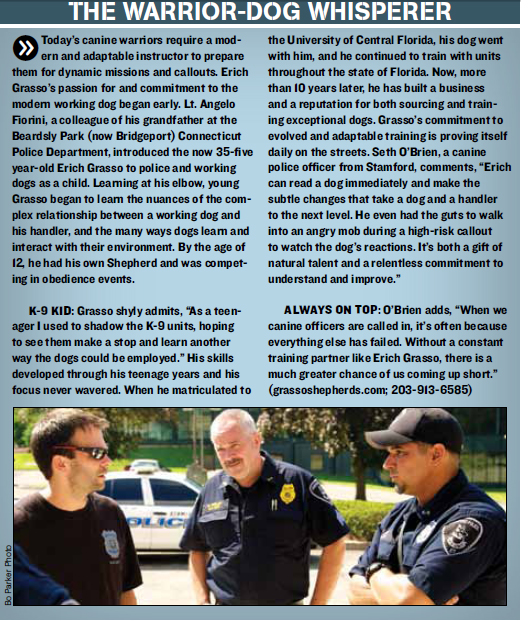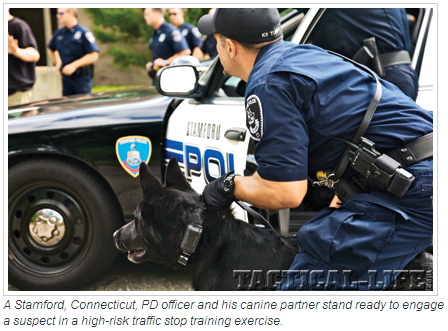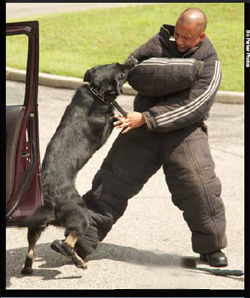
DOGS OF WAR
Posted by Len Waldron.
Insider look at the new breed of defend-and-attack K-9 that has emerged.
(Excerpts from the Tactical Weapons magazine)

MAKING THE CUT
Modern working dogs typically come from a small number of preferred breeds (German Shepherd, Belgian Shepherd, Belgian Malinois, and Labrador Retrievers are some of the most common), and of those, few make the cut for ultimate selection. For both military and law enforcement duties, nearly 30 percent of candidates are eliminated for reasons such as unstable temperament, lack of courage or poor athletic ability. Erich Grasso, a trainer and breeder of working German Shepherds in Connecticut, stresses the value of proper breeding and selection programs. “Between 24 and 36 months old, the dog’s character is fully formed. We have to see strong nerves, which means an ability to handle stress. These dogs must go from boats, to patrol cars, to planes and all the while be around people. They have to have a balance of fight, drive and sociability. Show dog lines or dogs bred simply for profit without quality control often result in weak-nerved dogs that will bite from fear or fail to handle a dynamic environment.” Such skills and characteristics do not come cheap. Over time, a healthy dog can be expected to serve for eight to 10 years.
RAISING THE WARRIOR
So how does a dog go from a sock-chewing puppy to a street and battlefield warrior willing to HALO from a high-performance aircraft or accompany a law enforcement officer down an alley behind a crack house? The first step is environmental conditioning. “You would be surprised at what will upset a dog, get his mind off the task at hand, and thereby put everyone in danger.” says Grasso. “We take our dogs to parking garages, put them in shopping carts and push them around where people are coming and going, slamming doors, honking horns, kids are screaming and tires are squealing. The cart is rattling, the dog is not in control of where it is going and there is a lot to adjust to. Fairly quickly, it’s all just a fun game, but they can’t be expected to adapt if all they have seen is a manicured backyard before they hit the street. Sometimes adaptation is totally out of context, but the habit of stabilizing themselves in strange environments is what we are trying to instill.”
 The dogs also have to possess a drive to hunt. Most working dogs are going to be asked to use their exceptional olfactory senses to enhance the capabilities of their handlers. It is estimated that the average dog has a sense of smell 100,000 to 1 million times greater than a human, and scent hounds have a much higher ability. Tracking the scent of blood, sweat, perfume and other odors from a fleeing suspect or lost child can spell the difference between safety and tragedy. When a military dog is asked to find explosives, it is absolutely life and death. “The dog has to hunt for what is not present,” adds Grasso. “He has to be obsessed with finding it, and have the skills and experience to stay with a track and find it again as environments change.” The dogs also have to possess a drive to hunt. Most working dogs are going to be asked to use their exceptional olfactory senses to enhance the capabilities of their handlers. It is estimated that the average dog has a sense of smell 100,000 to 1 million times greater than a human, and scent hounds have a much higher ability. Tracking the scent of blood, sweat, perfume and other odors from a fleeing suspect or lost child can spell the difference between safety and tragedy. When a military dog is asked to find explosives, it is absolutely life and death. “The dog has to hunt for what is not present,” adds Grasso. “He has to be obsessed with finding it, and have the skills and experience to stay with a track and find it again as environments change.”
TRAINING TO FIGHT
Perhaps the most important factor for the multi-purpose police and military dog is the fight drive. This critical element is not the willingness to bite something or someone but the courage and control to take down a target on command, no matter the environment. “We want the dog to be actively confident enough to engage a target and then immediately turn off, on command. In other words, do what they have to do with conviction, and then go lie down without missing a beat. The dogs must be willing to engage suspects in the dark, on the run, in the woods, or on an open, busy highway. Their courage has to be unshakable.” Critical to the successful employment of the canines is the thoughtful pairing of the handler. Grasso finds the toughest challenges are not the dogs but the handlers. “The handler and canine must be a united team. They must bond, train hard and solve problems together. Not just any officer can handle being a canine officer.” Dogs and handlers have to train together. A fresh dog is like a rookie cop—they have to see and feel the street, learn the signs and the ebb and flow of their job and the habits of the people they work to protect. Even an experienced handler paired with a young dog, or an experienced dog with a new handler, must learn one another’s habits and idiosyncrasies. The best teams train until they are almost telepathic.
 FORCE MULTIPLIER FORCE MULTIPLIER
People have an innate fear of being attacked by an animal of any kind. Adding to that fear is the knowledge that, when unleashed, the dog is all-on. A dog won’t just “kind of” bite you, or “sort of” chase you. They are an all-out, focused force of nature moving low and fast with a mouth full of teeth. Where a suspect may be well practiced in the art of running his mouth to control a situation, a dog won’t respond, and he knows it. Just the presence of the dog draws a line in the sand that frequently keeps a situation under control. Grasso adds, “Many officers have encountered suspects that would fight three cops but had no interest in dealing with a single dog.” Crowd control is another scenario where the presence of a dog has a calming effecton a circumstance. Knowing that the police are unlikely to fire their weapons, an angry mob may become violent towards law enforcement officers. Grasso notes, “Ninety percent of people are more afraid of a dog than a handgun.”
|